Second of a three-part essay on my wife’s midlife reinvention. Here’s Part 1. Rather listen to it? Click the audio widget … that’s no AI voice reading the story, that’s me! You can now subscribe to the audio version as a podcast.
***
Diane and I were excited about our first research road trip, a 2,000-mile excursion to Mendocino County, California. It’s where Clarina Nichols is buried and where she spent the last 13 years of her life, after deciding she was better off there than in Kansas.
Clarina had spent 1864 and 1865 in Washington, D.C. She and her daughter Birsha served as clerks in the Treasury and Army Quartermaster departments, replacing men who’d gone off to fight. Clarina also went through the revolving door of matrons at the troubled Colored Home run by the National Association for the Relief of Destitute Colored Women and Children.
Mother and daughter returned to Kansas and found their beloved Quindaro all but abandoned. Many of the town’s buildings had been torn down for firewood by Union troops who camped there during the war. Then in 1867, Clarina’s male allies abandoned her. That year the legislature put two measures on the ballot that would have altered history by giving the vote to women and Blacks in the state. Susan B. Anthony led a parade of national suffrage leaders to Kansas to help Clarina campaign for the measures. But leading Republicans backpedaled on their early support and both measures were soundly defeated at the polls.
In her final four years in Kansas, Clarina turned away from politics. She divided her time between farming, caregiving and keeping up with the women’s movement from afar. Her youngest son George married a Wyandotte Indian named Mary Warpole. After Mary fell ill, the task of raising their three children fell to Clarina.
Then her daughter Birsha accepted a marriage offer from a Civil War general and moved back East. Besides breaking her mother’s heart, Birsha left Clarina in charge of a sickly teenage girl named Lucy that she’d brought home from Washington. We only know this from a single letter that Clarina wrote to her daughter-in-law in 1871, but this letter gave Diane more pause than anything else in her research.
From what Diane gathered, Lucy was living at the Colored Home when Birsha took pity on her and, according to this letter, “wept and begged” her mother to let her take the girl with them. Clarina was opposed, but relented after Birsha pleaded with her, saying she wanted someone “to love and care for.” But once Birsha was married and had a white stepdaughter to care for, she simply left Lucy behind in Kansas.
Clarina was none too happy about being stuck with this sullen teenager. She wrote that the child had seemed so “white and pretty” at first, but that she now saw Lucy for what she truly was — “a natural born thief and a liar.” She added, “I shall get rid of her as soon as I can.”
Clarina was hardly a saint among women, but this letter seemed way over the top for her. It troubled Diane a long time. She wondered how Clarina could lash out like that, especially since it was her daughter, not Lucy, that she should’ve been mad at.
Re-reading the letter through caregiver’s eyes, I have a new perspective on it. Clarina wrote that letter in 1871, her last year in Kansas. Lucy had been living with her for three years. Lucy had likely contracted a chronic illness at the Colored Home, which was notorious for its filth. One matron found the children “eighty in number, and not ten healthy ones in all, and not one free from the most disgusting parasites.”
In her letter Clarina reports having to nurse Lucy through a long illness after Birsha’s departure. Even when healthy, Lucy would’ve been a handful for an older woman who herself was not in the best of health, and was also caring for George’s sick wife and three grandchildren.
Correspondence was Clarina’s lifeblood, the way social media is for some people today. She wrote constantly — sometimes for publication in newspapers, sometimes to stay connected with allies in suffrage, and sometimes to unburden herself. Always mild-mannered in person, Clarina could complain bitterly to a far-off friend or relative about low pay for a speech or a sexist insult or the physical ailments bothering her at that time.
To me, the simplest explanation for the Lucy letter is that she wrote it when she was at the end of her rope. Anyone who has ever been an overwhelmed caregiver (or has had to delete a tweet) should be able to relate.
***
Clarina wrote that letter to her daughter-in-law Helen, who lived in Northern California with Clarina’s son Aurelius and their family. He had a successful photography studio and a newspaper.
I’ve always loved the story of how Aurelius met his wife Helen, and now that I’m a caregiver I love it even more. On her first homestead Clarina counted among her neighbors old John Brown, the God-fearing abolitionist. This was the time of “Bleeding Kansas,” a period of intense lawlessness among pro-slavery and free-state settlers that served as a backdrop to the political struggle that was tearing the nation in two.
In 1854 Kansas Territory was opened to white settlement. Pro-slavery Missourians flooded into Kansas and stuffed ballot boxes in the first election, resulting in a pro-slavery legislature. Franklin Pierce, a Northern president who relied on Southern support, turned a blind eye to the shenanigans.
Then came May of 1856 and two events that triggered John Brown. First, the free-state capital of Lawrence was sacked by pro-slavery forces. The next day, abolitionist senator Charles Sumner was savagely beaten on the floor of the U.S. Senate after delivering a fiery speech on Kansas. These events caused old man Brown and his sons to lose their minds. They went at night to a settlement of families on Pottawatomie Creek who were said to be allied with the pro-slavery cause. They called the menfolk outside, then they attacked them with broadswords, killing five.
After the massacre, a posse led by a deputy U.S. Marshal went looking for old Brown. His family quickly pulled together a militia of sympathetic neighbors. Clarina was out East settling her late husband’s estate and stumping for Republicans. So she wasn’t there to stop her two oldest boys, Howard and Aurelius, from joining John Brown’s band.
The free-state men surprised the federal posse at Black Jack, near Lawrence. The resulting skirmish is now considered the first-ever military battle over slavery on U.S. soil. On that day the old man and his militia prevailed, and John Brown was never charged in the Pottawatomie massacre. But in the fighting, Aurelius took a bullet and limped to a nearby cabin for help.
The McGowan family took in Aurelius and cared for him during his long recovery. Specifically, 18-year-old Helen McGowan cared for him. The two got married in 1857. By then Aurelius, Helen and her parents had decided they’d had enough of Bleeding Kansas and joined a wagon train to California.
Clarina wrote that letter about Lucy in exasperation and sent it to her daughter-in-law Helen in California. As I’ve argued, Clarina was overwhelmed with the demands of care, needed help and was ready to move someplace where should could get help. And by the time she wrote that letter in 1871, a transcontinental railroad existed that could carry her to California in less than two weeks.
Clarina, George, Mary and their children, but not Lucy, boarded a third-class rail car and headed west, arriving in Ukiah, California, on New Year’s Day 1872. In time Mary would pass away and Clarina, though crippled by rheumatism and bothered by chronic bronchitis, raised her grandchildren, home-schooling them from her bed. “I am a cheerful invalid,” she would say. Clarina also contributed a chapter to the monumental History of Woman Suffrage and kept up correspondence with her eastern allies until the last days of her life in 1885.
Aurelius and Helen’s daughter Grace would become a renowned regional painter and Ukiah’s leading cultural figure. The Grace Hudson Museum, begun in her 1911 Craftsman bungalow and later expanded into a large, modern gallery, contains the family archives. Museum staff were at work on the first-ever permanent exhibit on Clarina I.H. Nichols when we reached out to them in 1999.
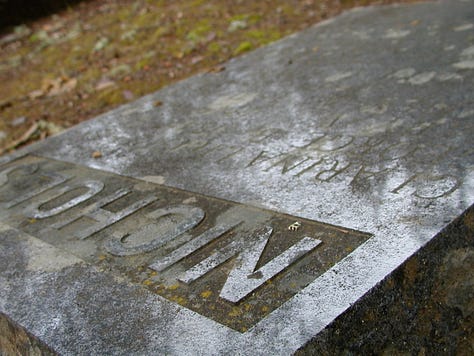
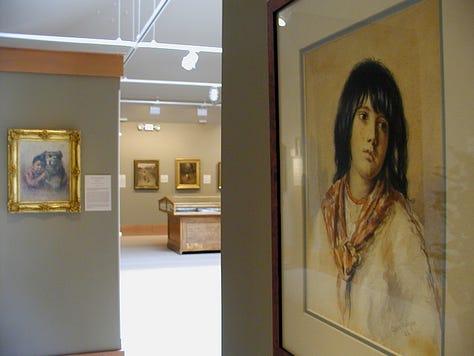
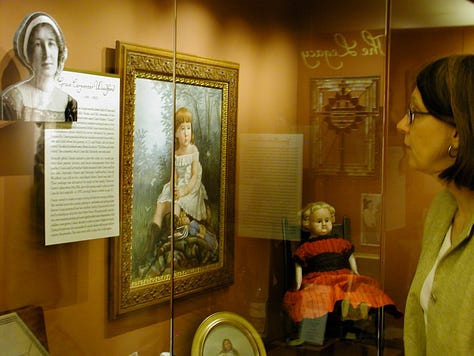

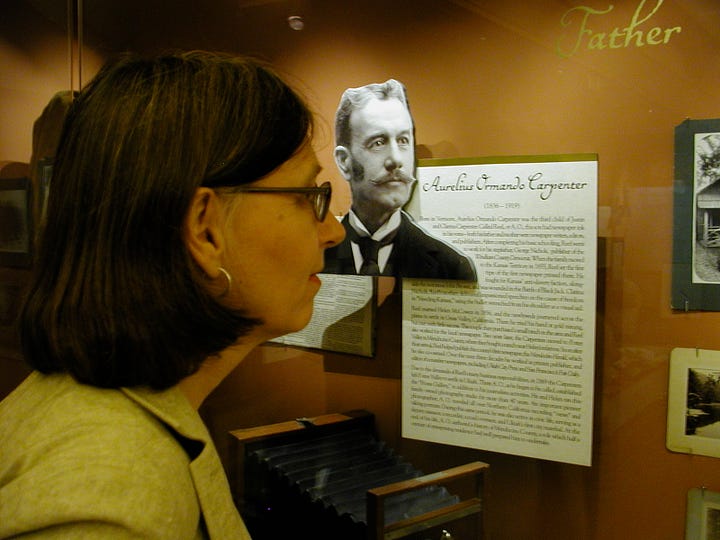
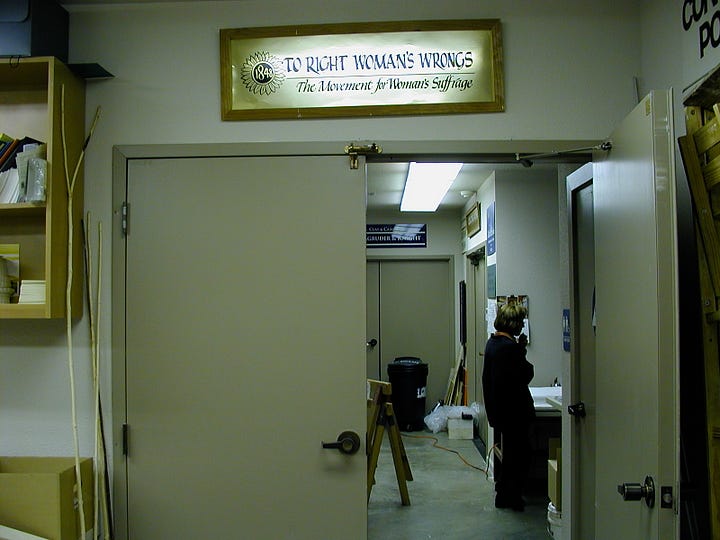

A few weeks before our planned road trip, Diane felt a lump on her breast. She’d had cysts before but this one worried her. Diane’s doctors weren’t sure what it was — a harmless cyst or maybe a small carcinoma. Once again Diane sought a second opinion, and this time all paths led to Amie Jew. A surgeon beloved by a legion of breast cancer survivors, Dr. Jew agreed to look at Diane’s tissue sample.
We packed our bags and awaited the test results. A call came from the hospital: The tissue tested negative! We high-fived, jumped in the car and drove to California. One afternoon I left Diane at the museum and went to a phone booth to retrieve our answering machine messages. There was a message from Diane’s doctor. He sounded … nervous. “Yes, if Ms. Barnhart could call us back right away,” he said, leaving no details. The next message was from Amie Jew. She wanted Diane to call her back.
Oh dear. The hospital hadn’t bothered to check with Dr. Jew before calling us with the “it’s negative!” report. And it seems Dr. Jew had a different opinion about the tissue sample. So Diane’s doctor had gone into CYA mode. (When we got home there was a certified letter from the hospital with the same vague message that was on our machine.)
On the drive back to the museum, I decided I wouldn’t tell Diane about any of this until we had left California. I had been in the room for all of her doctor visits. I knew that the lump, tumor, cyst, whatever, wasn’t aggressive. I also knew that Diane had a 99-plus-percent chance of survival if she had it removed. Telling her now would make no medical difference and she would want to cut her research trip short. At the very least she would worry about it until we got home.
Sooner or later, every cognitive caregiver learns to play fast and loose with the truth. There’s even a high-sounding phrase for it: compassionate deception. People with dementia can’t regulate their feelings. If I say the wrong words, Diane might have a meltdown. So I’m selective in what I disclose. Of course you should be as honest as you can with your loved ones, but there were many occasions over 30 years when I needlessly stepped on Diane’s feelings.
I told her the news on the drive home. Diane thanked me for not telling her sooner. Dr. Jew removed the lump. Then, while recuperating in the hospital, Diane informed me that she had edited her last textbook. This wasn’t a request. She had said yes to me without hesitation when I asked to quit my job, and she knew I would do the same for her. From then on it was all Clarina all the time.
The following summer we entered the Race for the Cure. Like most of the hundred or so women on Team Amie, Diane opted for the 1-mile “fun walk” through downtown KC. I joined her. At one point Diane challenged me to a footrace. We set a target a block or two down Pershing Road and sprinted toward it. I lost — badly.
We had a good laugh at how out of shape I must be to get boat-raced by my wife. It was only months later that we looked back and saw what we couldn’t see that day: A man in his 30s of ordinary fitness should have no problem keeping up with a woman in her 50s of ordinary fitness in a short sprint.
That fall we loaded up the car and headed to Vermont. The trip to California was a classic, pre-digital-age archive dive. We spent most of it in one room inside a modern museum. Vermont was more like living history. The house where Clarina Nichols was raised over 200 years ago was still standing on the village square of West Townshend. The family that was living there invited us in for a tour; they knew who Clarina was.
The church that the Howard family attended and where 17-year-old Clarina Howard took her year of extended schooling was still there. Here’s a video of scenes I took around West Townshend, including the Howard house (the white one), other buildings on the village square, and the historical markers for Clarina and her cousin Alphonso Taft (whose son William Howard Taft would become a U.S. President).
Over in Brattleboro we found the building where Clarina’s second husband, George Washington Nichols, published the Windham County Democrat. By the end of its run in 1852 it was being edited by his wife — George was too ill to continue the work — and the paper had separated from the Democrats over slavery and woman suffrage. We met members of the Townshend Historical Society, who were Clarina’s biggest boosters and treated us like VIPs. And we stayed with Lyn Blackwell, who was working on an academic biography of Nichols and had shared valuable research finds with Diane.
Afterward we drove to Massachusetts to see friends. I can still remember the completely exhausted feeling I had after hoisting my luggage up to the top floor of their townhouse. My head spun. I could feel my heart pounding in my chest. Something was up for sure. And yet, just before our trip we had visited the clinic at the hospital — the same hospital that had whiffed on Diane’s lump the year before — where a third-year resident looked me over and declared me a perfectly healthy male who just had a lot of earwax. He never did a blood test.
On a Friday night that November we attended a Kansas City Star gala at Union Station. The next morning around 5 a.m., I awoke with a 104-degree fever. I tried getting out of bed but could hardly stand up. Our neighbor drove us to the ER, where a doctor immediately triaged me to a bed. My spleen was the size of a football. “You look like you’re pregnant,” Diane had commented earlier. Someone tested my blood and found that I was out of platelets, out of hemoglobin, out of neutrophils (the white blood cells that fight off infections). The ER doc told Diane that it looked like leukemia.
Fortunately, testing later that day revealed that it was a chronic form called hairy cell leukemia. A front-line chemotherapy had been developed a few years earlier. According to the oncologist who treated me there, it was 90 to 95 percent effective in wiping out hairy cell leukemia. Great news — except that I didn’t fit the profile. The typical hairy-cell patient is a man in his late 50s or early 60s. I was 35. It seems my relative youth made my disease more resistant to front-line treatment. The chemo did nothing for me except make my whole body break out in a burning rash.
Diane found a Chinese medical practitioner in the area who treated me with acupuncture and herbs. I searched the scant online medical literature as I waited for my oncologist — a grim fellow with an on-brand mustache — to get back to me. Finally he said he would perform a second round of the failed chemo. Also, he wanted me to know that he disapproved of Chinese medicine.
That did it. Diane reached out to her brother-in-law, a gerontologist in New York, who offered to find the leading hairy-cell clinicians around the country and ask their opinion. None of the doctors he spoke with thought a 35-year-old patient should be getting a second round of the failed chemo. Armed with this information, we confronted my doctor, knowing it was likely our exit interview. He wouldn’t budge.
I met with a respected hematologist who had a large private practice in town. He said there was a trial underway at M.D. Anderson Cancer Center that would be perfect for me, and he offered to reach out to a colleague there. Okay, but how was I getting to Houston? Commercial flight is a dicey proposition for someone with zero immunity. Then Diane said she knew a coupla Minnesota farmers with a Cessna. Her brother Donald and his son Steven said they’d be honored to transport us to and from Houston.
After the first round of treatment, I did the rest of my infusions in KC. The clinical trial was a success. But it would be several months before it was safe to go out in the world, so I quarantined on the third floor of our house and Diane took care of me.
It’s hard not to look back at this give-and-take of dependency — taking turns as the household breadwinner and the caregiver for the other — and see that it was the most powerful determinative force in our marriage, like children are for other couples. Would Diane have made her midlife pivot if I wasn’t there for her? Would I have gotten my dream job, or had the nerve to leave it 15 years later, if not for her love and support?
***
While I convalesced upstairs, my legally blind caregiver managed to crack out a draft of her Clarina Nichols biography. She titled one of the chapters “Woman on a Mission,” which could just as well have described herself.
For years Diane had been writing and editing for young readers. She was familiar with the dreary monotony of women’s history titles available to that audience. A biography of this western feminist would be a welcome addition to the Young Adult market. But that first draft showed her the limits of the YA format. Much of her research simply couldn’t be used in a short book with a fast-moving narrative. And forget about endnotes — who did those in YA?
Diane realized she had higher aims for the first-ever biography of Clarina Nichols. She wanted to produce a complete work of scholarship, aimed at a general audience. And already there was an audience forming.
After Diane’s article appeared in the Kansas City Star, she had received an invite from the Kansas Women Attorneys Association to be the featured speaker at their state convention. That introduced a new challenge. Although Diane had retrained her brain to rely on peripheral vision, she still wore thick glasses and hovered close to the computer screen. That was fine in the home office, but my wife was not about to read a prepared speech to a roomful of attorneys holding the pages up to her face.
The only option was to memorize her speech. Which she did — a one-hour talk on Clarina Nichols, committed to memory and flawlessly recited. Once she cleared that hurdle, the world was her oyster. The human brain is amazing.
And now we come to my favorite twist in the story: Diane, age 60, takes up acting.
It began with a museum visit. We drove into the small town of Lecompton, where they were holding Lecompton Days, with carnival rides, local bands and a Bleeding Kansas reenactment. As we arrived we were greeted by a serious-looking reenactor who was not dressed in uniform but in the gentlemanly attire of the era, which in Kansas often included a weapon protruding from one’s boot. “Excuse me,” Diane asked the man, “is that a Bowie knife?”
This was our introduction to Tim Rues, director of the historic site at Constitution Hall, built in 1855 when Lecompton was the pro-slavery capital of Kansas Territory. As we learned in Part 1, Kansas history buffs know a prospect when they see one. Within minutes Diane had an invitation from Tim to speak at the site’s annual Bleeding Kansas lecture series.
It was the first of many invites over the years. Upstairs at Constitution Hall is a unique venue, steeped in politically incorrect history — besides the slavery business, the Klan used to meet there in its Rotarian heyday.
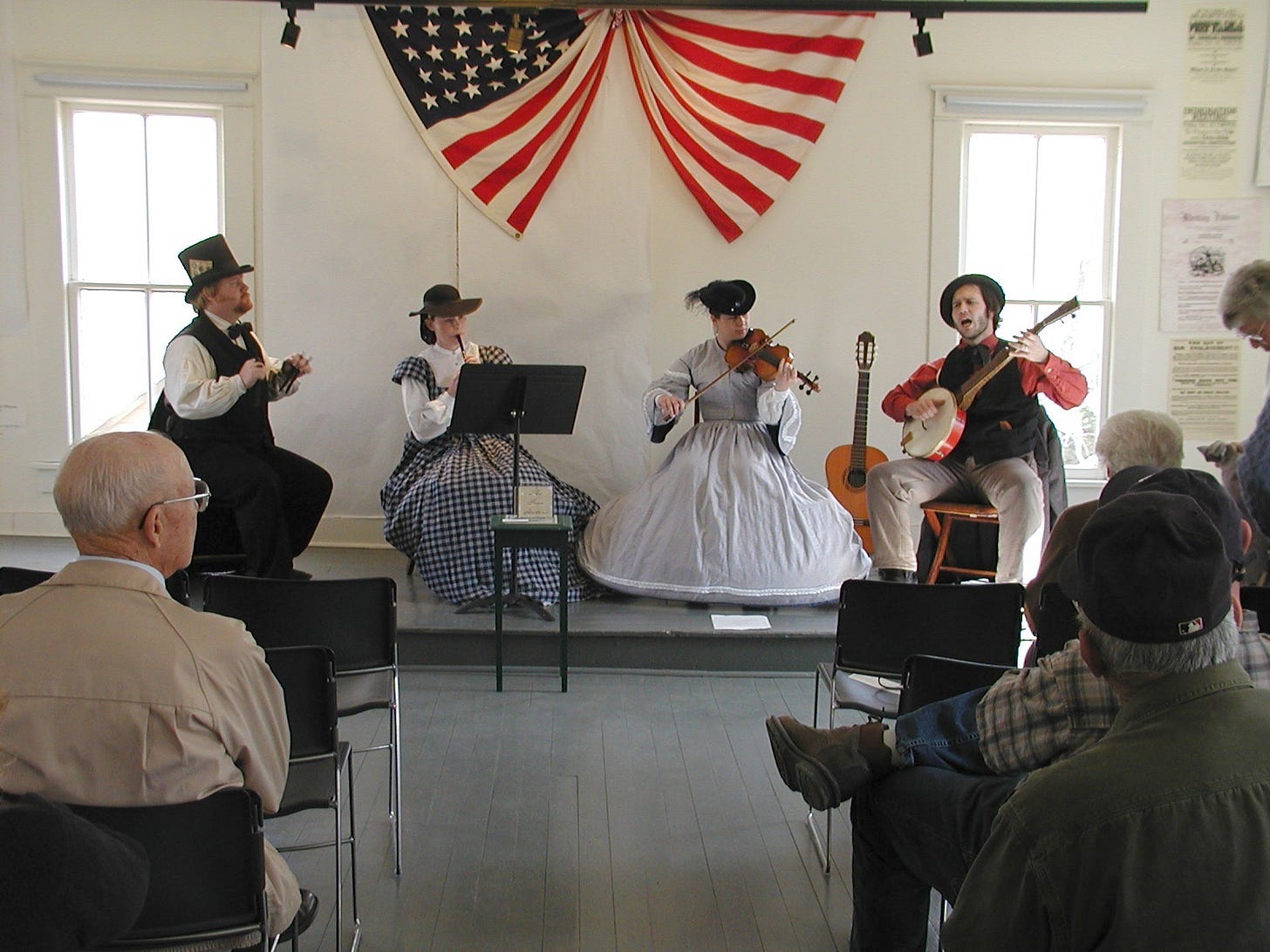
The Bleeding Kansas series kicks off on the last Sunday of January with a Kansas Day program. For those of you unfamiliar with Kansas Day or the importance of January 29th in the Sunflower State, that was the date in 1861 when Kansas was admitted to the Union following much turmoil and delay.
Kansas Day is not an official holiday but it might as well be one. Every year buses of children descend on Topeka to tour the magnificent statehouse and gawk at the 20-foot-high mural of John Brown. In classrooms across the state, students read stories of Bleeding Kansas and learn that the state motto, Ad Astra Per Aspera, means “To the stars through difficulties,” a lofty Latin phrase coined by free staters to celebrate their triumph.
In the end, neither guns nor election fraud nor the Dred Scott decision nor two pro-slavery presidents could defeat demographics. More people from the North moved into Kansas than from the South, and Northerners were generally anti-slavery, though few shared Brown’s magnanimity toward black people.
Even so, Congress refused to act on the 1859 free-state constitution, which meant that Clarina and other Kansas women had to wait for their rights. It took the election of Abraham Lincoln, the secession of seven states and the expulsion of their representatives in Congress for Kansas to become the 34th state.
***
Diane’s interest in Clarina Nichols soon became known to Tim Rues’s friend Howard Duncan. Howard extended an invite to join his troupe of historic thespians known as the Lecompton Reenactors. Since I was along for the ride, he invited me too.
Bleeding Kansas was indeed bloody, but mostly it was a war of words fired from the mouths of politicians and the pages of the partisan press. Howard Duncan created the Lecompton Reenactors to bring the free-state/slave-state struggle to life with monologues delivered by real-life characters on both sides. They entertained audiences by haranguing and dunking on each other while telling the story of Bleeding Kansas.
Howard wrote the monologues. He gave me a script he’d written for a pro-slavery minister named Thomas Johnson. He wrote a Clarina Nichols script especially for Diane, who was not especially thrilled with it. After negotiations and a rewrite, though, she agreed to join the Lecompton Reenactors. As you can see from these clips, the Reenactors took their show just about anywhere. I have no idea why they were clanging those bells.
I had a lot of fun playing a slaveholding man of the cloth. As for Diane, she had stage presence from the get-go. She never cottoned to that script — she wondered, Why not just use the actual words of Clarina Nichols? But she had dipped her toes in the acting waters and she enjoyed it. Soon she would get the chance to write her own script and take center stage with it.
The Kansas Humanities Council announced that it would stage a “Bleeding Kansas Chautauqua” in the summer of 2004. Inspired by the traveling chautauquas that toured the Midwest in the late 19th and early 20th centuries, the KHC would bring a historical road show to towns across Kansas. They were looking for people with both academic rigor and dramatic flair to give talks by day and performances by night. The KHC was casting six roles: Abraham Lincoln, Frederick Douglass, John Brown, senators Stephen Douglas and David Rice Atchison … and to offset all that testosterone, Clarina Nichols.
Diane had never acted before Lecompton and had only recently begun taking graduate classes in history. But I knew this was her moment. I told her there was no one who knew Clarina Nichols better and could bring her to life on the stage. I can’t recall if Diane had any reservations, but if she did she got over them fast. It took her one week to write a 30-minute monologue in which Clarina tells her story in her own words, and a little longer to memorize it.
Then she needed an audition tape. As it happened, professor Steve Collins had asked Diane to appear on the community college’s TV station to discuss her work. I reached out to the TV show’s producer, who agreed to stay after the interview and film Diane’s audition. When we got to the studio we found that the equipment was so old that everything was still being filmed in black and white. How perfect was that? Diane did the scheduled interview, then changed into her costume, transformed into Clarina, gave her performance, took home two copies of the videotape, mailed one to the KHC … and waited.

In Part 3 …
Two decades later, an unexpected epilogue to the Clarina Nichols story moves one of us to tears. Lots and lots of tears.
Endnotes
Whenever I hear the words compassionate deception, I have the irresistible urge to rewatch Jim Gaffigan’s routine on lying.
We were early supporters of the effort to restore the Black Jack Battlefield, where Clarina’s son Aurelius was wounded. When we wrote our travel guide we rated Black Jack as one of the must-see history destinations in Kansas.
There’s a happy ending to the story of the hospital that repeatedly failed us. In 1998 the University of Kansas Hospital (also known as KU Med) broke free from state oversight, formed its own independent board and began to improve in every facet. It eventually bought the oncology practice where I’d wound up and became the region’s top cancer center. I changed to KU Med for primary care in 2016 and was so impressed that I brought Diane over in 2019. It was through our primary care doctor that we were referred to KU Med’s dementia practice, where Diane received an accurate diagnosis and exceptional care.
I recently learned from Stephen B. Oates’s Abraham Lincoln: The Man Behind the Myths that Carl Sandburg had also been aiming at a young audience when he started his Lincoln biography project. “What began as a teenagers’ book swelled into a massive ‘life and times’ that took fifteen years to complete and ran to 3,765 pages in six published volumes,” Oates writes. Here’s the thing: Teenagers like to read grown-up books. Diane met with lots of middle and high school girls over the years, many of whom did National History Day projects on Clarina Nichols using her biography.
Listen to The Diane Project
Beginning with this newsletter, every new story will be released on Substack at the same time as its audio version (read by me). It will be posted at the top of the story. You can also listen to the audio through your favorite podcast app. The podcast version will include a transcript but it won’t have the Endnotes or any of the pictures and videos that you see in this newsletter.
Thank you’s
Thanks for shopping TDP’s Bookshop links, which benefit the Robert H. Levine Foundation for Lewy Body Dementia Research. Bookshop now features ebooks.
Thanks for checking out the history titles that Diane and I wrote and published.
Thank you for sharing this newsletter with others.
If someone forwarded The Diane Project to you, consider subscribing. It’s free, with newsletters once or twice a month.
When you subscribe, I’ll send you What Every New Cognitive Caregiver Needs To Do. It’s the guide I wish I had when I was starting on my journey.
Thanks for leaving your thoughts and questions in the Comment area.
Above all, thank you for reading.
Take care,
Aaron





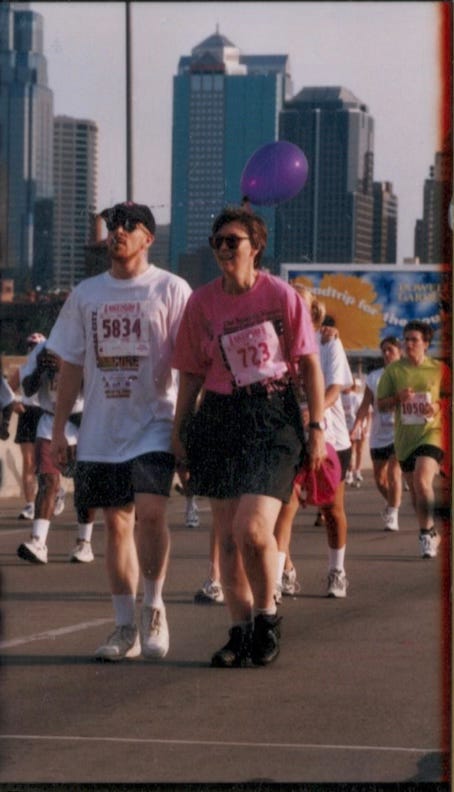

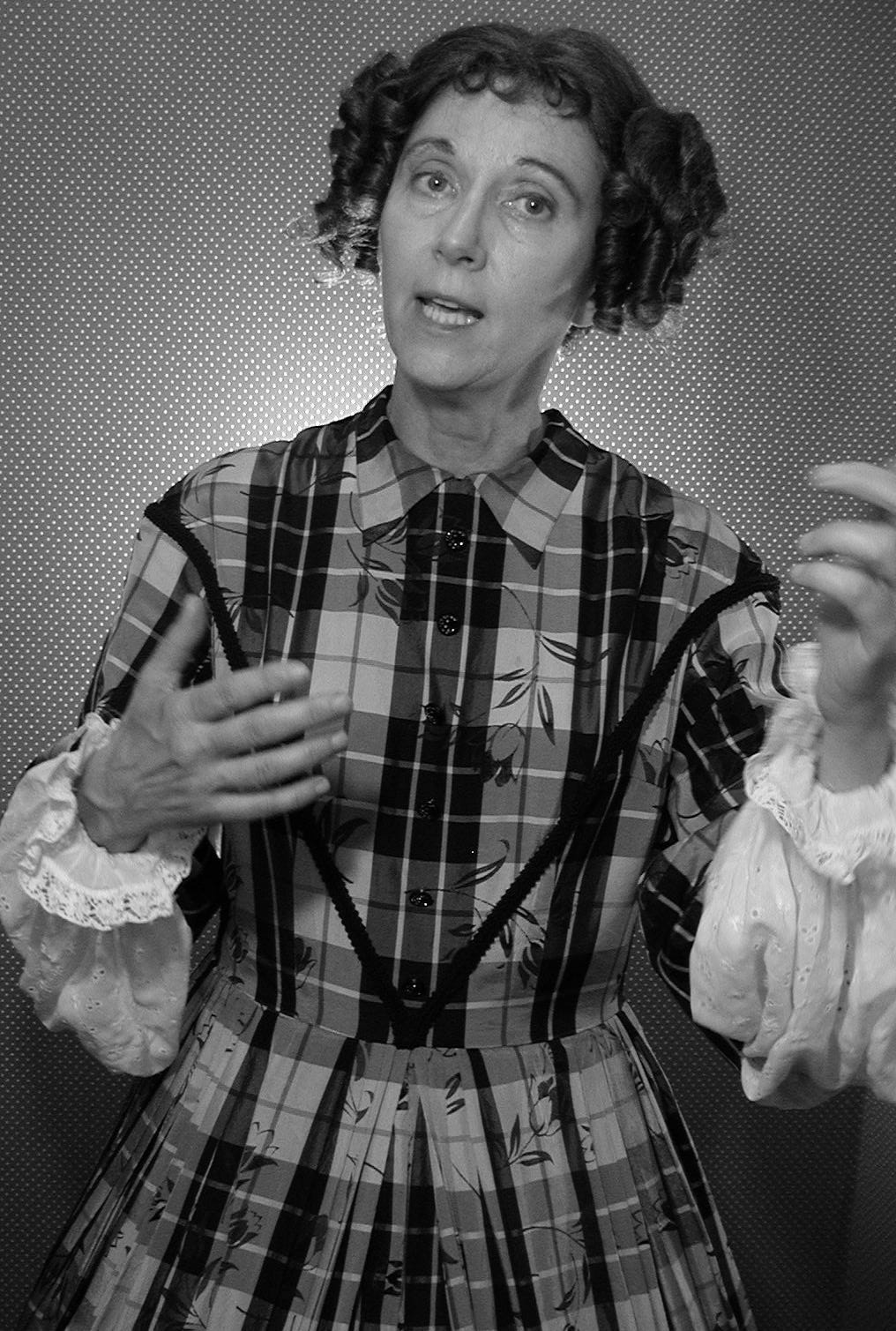
Dear Aaron and Diane,
Thank you for sharing this part of your l journey. I of course knew bits and pieces of it from being at Rainbow with you, but I especially was glad to learn more about your "acting careers, and the
writing of Diane's book. Oh my! As I am destined to lose my central vision, that totally amazed me to think of Diane writing that entire wonderful book using her peripheral vision. Tonight, give her an extra hug from June, and thank her for being such a strong role model for me and others.
Love and prayers,
June